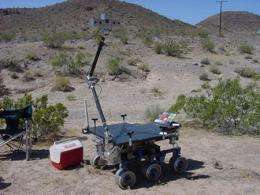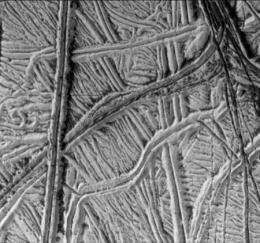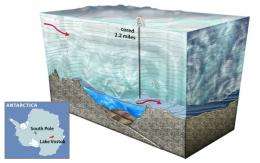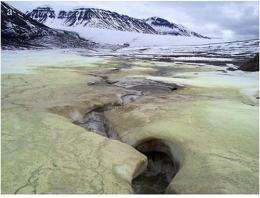Where in the World is Europa?

Before they can be sent out to explore planets or moons, rovers first need to be tested in the field. While there is no perfect analog for Jupiter’s icy moon Europa, there are various spots on Earth and elsewhere that are similar enough to conduct trial runs.
Instead of flying to Europa without first testing what a mission there might experience, now a number of sites on Earth — and beyond — that mimic the Jovian moon are being uncovered that could help explorers conduct trial runs.
Missions to Mars such as the Mars Exploration Rovers were exhaustively field-tested in "Mars Yards" — areas whose terrain mimicked the red planet. In much the same way, researchers would like to rehearse missions to explore Europa using analogs of that moon on Earth.
Landing and moving on Europa could prove especially tricky given its icy and cracked surface. With all the curiosity over whether Europa might host alien life, scientists also would like to vigorously test methods that look for evidence of life, yet avoid contamination of results by any Earth microbes that might inadvertently hitchhike on our space vehicles.
"Before we can build landers, we need to understand these environments, and the interplay of biology and chemistry under these unusual conditions," said astrobiologist Damhnait Gleeson at NASA's Jet Propulsion Laboratory. "Designing missions to go to Europa presents many technical challenges, from the low temperatures to the harsh radiation."
The scientists will review the state of research into Europa analogs in a forthcoming issue of the journal Advances in Space Research.
Lake Vostok
Probably the most important analog for Europa on Earth is Lake Vostok in Antarctica. Just as Europa’s ocean likely lies beneath perhaps some 9.3 miles (15 km) of ice, Lake Vostok is located roughly 2.5 miles (4 km) beneath the surface of the East Antarctic ice sheet. The ice-penetrating radar through which Lake Vostok was discovered is expected to prove valuable on Europa, and the lake is also dynamic like Europa is expected to be — for instance, geothermal heat at Lake Vostok is estimated to drive water flow at rates not too different from what is expected on that moon.

The question of whether or not there is life in Lake Vostok, as with Europa, is a challenging one to answer. While some measurements of ice near the lake turned up a variety of microbes and organic molecules, other research only turned up the DNA signature of specialized heat-loving bacteria, while still other studies have turned up no microbes whatsoever. The stringent procedures developed to decontaminate tools and thus get clear results from Lake Vostok should prove helpful for Europa missions as well.
Lake Tirez
While Lake Vostok may reflect those parts of Europa made of mostly pure water ice, the extremely salty hyper-saline waters of Lake Tirez in Spain may bear chemical similarities with Europa's hidden liquid ocean. The waters of Lake Tirez are loaded with magnesium, sodium, chlorine and sulfates, and when frozen, these brines resemble readings of Europa procured by NASA's Galileo spacecraft.
Indeed, instruments used to study frozen Tirez brines have already flown in space, such as the Thermal and Evolved Gas Analyzer on the Mars Polar Lander and Phoenix missions, so they or their descendents could also find use in Europa landers.
Lake Tirez also possesses two forms of life — photosynthetically-sustained communities as well as life that relies on inorganic compounds for respiration in an airless, subsurface realm. This lake could prove a key testing ground for instruments designed to look for life on Europa. For instance, scientists have detected microbes in the lake using compounds that fluoresce in contact with biological materials.

The extremely salty waters of Lake Tirez pose challenges for missions there, making it a good place to test Europa craft. "Hyper-saline brines are known to have corrosive effects on many metals," Gleeson said. "Corrosion research is ongoing at sites such as the drilling operations targeting geothermal brines at the Salton Sea, into materials that are more resilient to these effects."
Borup Fiord Pass
Extraordinarily rare sulfur springs at Borup Fiord Pass on Ellesmere Island in the Canadian High Arctic could serve as the best chemical analog to the Europan surface. As such, the glacial deposits there could give scientists a good idea as to what to look for in landing sites.
Europa is covered with sulfur-rich materials concentrated along cracks and ridges on its icy surface. Although the Galileo space probe's spectrometers captured near-infrared signals from Europa — "spectral fingerprints" that could help identify what these substances are — so far it remains uncertain what exact blend of compounds matches up with this fingerprint. To help identify these mysterious compounds, researchers are investigating Borup Fiord Pass, which possesses combinations of sulfur-rich springs and glacial ice that are very rare on Earth and resemble the Jovian moon's surface.
Scientists have examined materials from Borup Fiord Pass not only in the field and the lab but also with satellites, using techniques that should prove useful when it comes time for spacecraft orbiting Europa to look for a spot to land. Moreover, microbial communities are present in the deposits from Borup Fiord Pass, and looking at the signatures that such life on our planet leave behind could be vital when scanning for life on Europa.

"Under these extreme conditions, microbial life on Earth cannot merely survive, but actually prosper," Gleeson said. "This is good news for the potential for life at Europa."
Alpine analogs
The faint red blooms of algae in the snowfields and glaciers of the Sierra Nevada Mountains in California could serve as a useful example of life that is detectable by the kind of remote techniques missions could use for investigating distant worlds. For instance, NASA's Airborne Visible and Infrared Spectrometer, which has flown in several aircraft, could image the colorful compounds in the snow algae Chlamydomonas nivalis.
Permafrost regions such as Siberia and Alaska also could prove useful analogs for Europa. Methane and other organic compounds might get released into the atmosphere in those icy regions, especially during the thaw season, and it is already possible for airborne and spaceborne instruments to detect such emissions. When it comes to monitoring such emissions on Europa, scientists will want to be able to determine whether or not they are signs of life.
Outer space
Aside from Earth, other sites that space missions have visited or plan to voyage to could prove helpful analogs for Europa. For instance, our own Moon is similar to Europa in terms of size, gravity, hard vacuum and the variable amount of light it receives. A return to the Moon in the next decade could yield important lessons for Europa. Although our Moon's surface composition is quite different from Europa's, an exception could be the icy deposits in our Moon's permanently shadowed polar areas. Moreover, the transport of dust or electrical charging induced by sunlight may occur on the Moon, and similar processes could occur but have not yet been considered for Europa.
Comets might also be useful. In 2014, the Rosetta spacecraft will arrive at comet 67P/Churyumov-Gerasimenko and deposit a lander there. Researchers are as yet uncertain whether its surface is Europa-like, and its low gravity introduces complications absent on Europa — for instance, Rosetta's lander will need harpoons and self-hammering spikes to anchor itself to the comet.
The future
Scientists would not only like probes to practice tasks familiar from past space missions, such as snapping photos and picking up samples, but conduct new ones as well, such as seismic readings. They also would like to expose instruments to as many environments as possible to help avoid unwelcome surprises, such as how the Mars Phoenix lander had problems ingesting soil samples because they were too sticky. Phoenix landed at high northern latitudes where soil moisture was apparently higher than at other regions on Earth and Mars that had served as analog test locations.
No analog is a perfect match for Europa. Still, "the similarities are more important than the differences in this case," Gleeson said. "The more different sets of conditions we prepare for, the better our chances of being prepared for the unexpected at Europa."
Source: Astrobio.net, by Charles Q. Choi

















